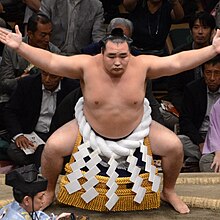| This article needs additional citations for verification. Please help improve this article by adding citations to reliable sources. Unsourced material may be challenged and removed. Find sources: "Arahitogami" – news · newspapers · books · scholar · JSTOR (June 2019) (Learn how and when to remove this message) |

Arahitogami (現人神) is a Japanese word, meaning a kami (or deity) who is a human being. It first appeared in the Nihon Shoki (c. 720) as the words of Yamato Takeru saying: "I am the son of an Arahitokami."
| Part of a series on |
| Shinto |
|---|
 |
| Beliefs |
| Major kami |
Important literature
|
| Shinto shrines |
| Practices |
| See also |
In 1946, at the request of the GHQ, the Shōwa Emperor (Hirohito) proclaimed in the Humanity Declaration that he had never been an akitsumikami (現御神), divinity in human form, and claimed his relation to the people did not rely on such a mythological idea but on a historically developed family-like reliance. However, the declaration excluded the word arahitogami.
In Shinto, it is normal that a superior person is to be revered as a God especially after they died, like Sugawara no Michizane or Tokugawa Ieyasu.
It is also linked to the Chinese concept of Worship of the living.
Overview
Hitogami (人神) , also known as "man-god" or "human deity," is a belief in Shinto in which humans are worshipped as gods during their lives or after their deaths. The term "Hitogami" is derived from the Japanese words "hito," meaning "human," and "kami," meaning "god." In Japan, this belief is also known as "ikigami" or "arahitogami," especially when the deity is a living person. This concept is distinct from the ujigami (Japanese: "guardian deity") belief system, which focuses on a deity's connection to a specific family or geographic origin. In contrast, the hitogami belief system emphasizes personal faith as the basis for membership in the circle of believers.
People who become human deities include sorcerers, priests, and others who possess special and unusual magical powers, tribal chiefs, kings, and others with superior skills, such as outstanding dancers, soldiers, and others, as well as physically disabled people, Confucian scholars, and foreign aliens who are different from ordinary people. In Japanese folk beliefs, human deities are diverse and can be divided into those who are deified during life and those who are worshipped as human deities after death.
The practice of deifying humans after death is a way to put to rest the legacy of those who have died with a grudge. Examples of the former include toya (head priests), miko (shrine maidens), and masquerading deities in the rituals of the miya-za. Throughout Japanese history, the hitogami and ujigami belief systems have interacted with one another. Examples of the hitogami belief system can be seen in the deification of heroes like Hachiman (god of war) and Tenjin (god of calligraphy), as well as in the ecstatic singing and dancing of Japanese festival processions, and in the charismatic leadership of some of Japan's "new religions."
In ancient societies, it was common for aristocrats who were defeated in political disputes to manifest their grudge as a curse after death and to offer sacrifices to gods in order to quell the curse.
This belief is prevalent in Japan and is known by various names such as "ikigami" or "arahitogami." People who become human deities include sorcerers, priests, kings, and others with special and superior skills, as well as physically disabled people, Confucian scholars, and foreign aliens who are different from ordinary people. The practice of deifying humans after death is a way to put to rest the legacy of those who have died with a grudge.
People as Yorishiro
Persons can play the same role as a yorishiro, and in that case are called yorimashi (憑坐, lit. 'possessed person') or kamigakari (神懸り/神憑, lit. 'kami possession').
Difference between akitsumikami and arahitogami
Akitsumikami is often translated as "divine" or "divinity", but some Western scholars (including John W. Dower and Herbert P. Bix) explained that its real meaning is "manifest kami" (or, more generally, "incarnation of a god"), and that therefore the emperor would still be, according to the declaration, an arahitogami ("living god"), although not an akitsumikami ("manifest kami"). Jean Herbert explains that, according to the Japanese tradition, the figure of the emperor would be "the extension in time" of the goddess Amaterasu and the previous emperors, representing a naka ima (中今?). Consequently, it would be inadmissible to deny its divine origin.
See also
Notes
- Nihon Shoki, Chapter 7
- ^ 字通, ブリタニカ国際大百科事典 小項目事典,世界大百科事典 第2版,普及版. "人神(ひとがみ)とは? 意味や使い方". コトバンク (in Japanese). Retrieved 2023-01-25.
{{cite web}}: CS1 maint: multiple names: authors list (link) CS1 maint: numeric names: authors list (link) - ^ "Hitogami | Japanese religion | Britannica". www.britannica.com. Retrieved 2023-01-17.
- ^ "Shinto Portal - IJCC, Kokugakuin University". Archived from the original on 2011-05-19.
- Iwanami Kōjien (広辞苑) Japanese dictionary, 6th Edition (2008), DVD version
- Herbert, Jean (1964). Aux sources du Japon: Le Shinto. Parigi: Albin Michel.
This article relating to Shinto is a stub. You can help Misplaced Pages by expanding it. |
| Shinto shrines | |||||||||||||||||||||||||||||
|---|---|---|---|---|---|---|---|---|---|---|---|---|---|---|---|---|---|---|---|---|---|---|---|---|---|---|---|---|---|
| |||||||||||||||||||||||||||||
| |||||||||||||||||||||||||||||
